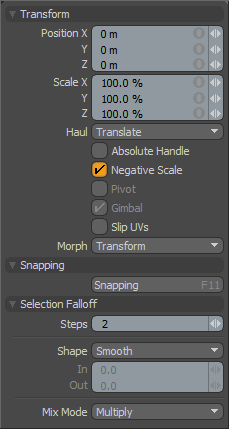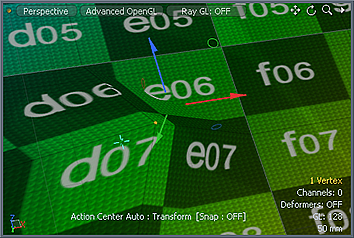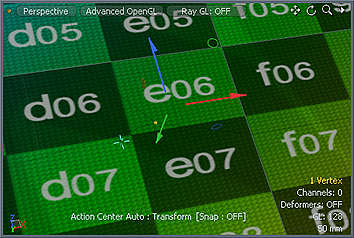
Found in the 'Deform' subtab of the modeling toolbox, the Flex tool leverages the 'Selection Border' action center and 'Selection' based falloff combined with the standard Transform tool to create a tool that provides a more natural, organic bending type deformation. Used in combination with 'Select Closed Loop' command, it provides the ability to pose meshes very simply. The tool has the standard transform widget which allows for direct manipulation of move, rotate and scale for the currently selected elements. The amount of transform applied to the selection is based on the Steps parameter. The default value of two results in a smooth falloff starting at the boundary of the selection. The tool's control palette includes direct numeric input of all transform values as well as a 'Haul' pop-up to determine what users wish to 'Haul', Absolute Handle option, Negative Scale choice, and direct control over the Selection falloff options.
 Transform--
Transform--
Position: Users may use the X,Y and Z input fields to apply specific offset distance values (calculated from position the object was in when the tool was activated). When adjusting an object interactively in the viewport, the 'Position' input fields will display the current offset distance applied, providing useful user feedback.
Scale: Users may used the X,Y and Z input fields to apply specific scaling values. When adjusting an object interactively in the viewport, the 'Scale' input fields will display the current scale factor applied, providing useful user feedback.
Haul: Users have three options available when hauling in the viewport (i.e. dragging the mouse when not using the tool handles), 'Rotate' allows the user to rotate, and 'Scale' would re-size the selection.
Absolute Handle: The 'Absolute Handle' toggle applies an additional function to the tool handles allowing users to scale the handle itself without affecting the transform amount. In some cases this provides finer control over very large or very small adjustments.
Negative Scale: The 'Negative Scale' toggle enables/disables MODO's ability to interactively apply negative scale values when manipulating the tool handles in the viewport. When disabled, users can always input negative values in any of the input fields directly.
Position Only: (Only in Items Mode) When enabled, only changes the position of the selected items, rotation is left unchanged.
Pivot: Disabled for the 'Flex' tool.
Gimbal: Disabled for the 'Flex' tool.
Child Compensate: (Only in Items Mode) The 'Child Compensate' toggle when disabled will pass along the transform value to any child items of the current selection, when enabled, the child items will ignore any transform values.
Slip UVs: (Only in Component Modes) UV values are generally fixed to specific vertices, subsequently further edits to the geometry may warp, deform or otherwise distort the UV values in undesirable ways requiring users to adjust the map or redo it altogether. To avoid this undesirable result, users can enable the 'Slip UVs' function so as to not disturb any existing UV mapping applied to the geometry.
 'Slip UVs' function disabled, note texture warping. |  'Slip UVs' function enabled, texture remains even. |
Morph: (Only in Component Modes) The Morph option determines how MODO treats stored Morph information when applying transforms to geometry (Move, Rotate, Scale, etc.). In previous versions of MODO, in order to transform a Morph along with its base, it needed to be selected in the Vertex Map list. If it wasn't, relative Morph map data when recalled would produce distorted, undesirable results. If users were unaware of the requirements, it was easy to accidentally mess up a model. To remedy this problem, there are now three options controlling how the Morph Map vertex data is dealt with when applying any transforms--
None- Unselected Morph data is not affected, though selected (visible) Morphs can still be transformed independent of their source.
Transform- With this option selected, Morph data is transformed along with base mesh.
Keep Positions- With this option Selected, Morph data is converted into a Absolute Morph Map and all vertices retain their pre-transformed positions.
Snapping--
Please reference the 'Snapping' Section of the documentation.
Selection Falloff--
Steps: This value determines the extent of the Falloff range, where each 'Step' represents a loop of polygons or a ring of edge sections. The greater the 'Steps' value, the further the Falloff attenuates.
Shape: The strength of the Falloff's influence can be controlled along the extent using a 'Shape Preset'-
Linear- Attenuation of Falloff occurs evenly across its range.
Ease-In- Strength of Falloff is greater toward the 'Start' position.
Ease-Out- Strength of Falloff is greater toward the 'End' position.
Smooth- Strength of Falloff is greater toward the center of the Falloff.
Custom- Users can use the 'In'/'Out' options to fine tune strength of Falloff.
In/Out: The 'In' value determines the strength of the Falloff nearer to the 'Start' position, where the 'Out' value determines the strength on nearer the 'End' side of the Falloff.
Mix Mode: In instances where there are multiple falloffs applied to a transform (using the 'Add' option of the Falloff menu), the mix mode defines how each Falloff interacts with the other.


